Consumer Perspectives Relative to Interpreting e-Commerce Acceptance in UAE
American Journal of Information Systems. 2017, 5(1), 21-26. DOI: 10.12691/ajis-5-1-3 . Published online: July 06, 2017
Abstract
1. Introduction
Despite these benefits, it is evident that many people are still reluctant to engage in e-commerce, due to various concerns such as trust and delivery issues. Trust issues result from a lack of touch and feel of the product, which makes consumers uncertain as to whether they will get the product they ordered. Delivery issues result from of delayed deliveries, a challenging problem, especially in cases of emergency. Other factors contributing to consumer reluctance include culture, attitudes and perception of the people from a given region, economic and demographic factors.
Researchers, however, argue that consumer behavior is a critical determinant of online shopping habits. Consumer behavior is defined as the study of processes used by people, groups, and organizations to select, acquire and dispose of products, experiences, and services for utility purposes, and how this behavior impacts both the consumer and the society as a whole. Volumes of research have been published on consumer behavior, which focused on psychology, sociology, and economics, as well as how perceptions affect consumer inclination toward engaging in online shopping.
The United Arab Emirates (UAE) is generally regarded as a tourist hub. According to Vel and Rodrigues 16, e-commerce was introduced in the UAE in 2009. The country has since enthusiastically embraced online shopping, resulting in the UAE’s rank among the region’s top five nations participating in e-commerce. This study examines the correlation between the advantages of online shopping and consumer intentions while web browsing. The results presented will provide clear consumer e-commerce behavioral patterns in the region, vital for effective policy formation.
2. Research Questions
The questions the study sought to answer include:
i. How does design quality of a website correlate with customer’s trust in the website?
ii. How does consumer’s attitude towards online purchases correlate with customer’s purchasing intentions?
iii. How does gender correlate with website design quality, and to what extent does trust and consumer attitude determine purchasing intentions?
3. Hypotheses
The following hypotheses were derived from the research questions above:
Hl0: There is no correlation between type of design quality of a website and user’s/customer’s trust.
Hla: The design quality of the website determines user’s/customer’s trust on the site.
H20: Online purchasing intentions are not determined by user’s attitude.
H2a: Customer's attitude in an online purchase determines online purchasing intentions.
H30: A consumer’s gender does not affect his/her trust in the website, either by assessing the design quality, influencing a consumer's attitude or the purchasing intentions.
H3a: A customer's gender affects his/her trust in a website from assessing the design quality, attitudes of customers as well as purchasing intentions.
4. Methodology
This study utilized data based on a cross-sectional study design. A previously designed questionnaire was used to collect data to trace out the patterns, attitudes, and perceptions of the UAE citizens about online shopping. The survey questionnaire was developed based on the previous literature review. A total of 125 participants took part in the study. The survey was divided into two parts: the demographic part of the questionnaire, which focused on the socio-demographic characteristics of the participants, and the second part of the questionnaire focused on the attitudes and the perceptions of the participants toward online shopping.
This study had two primary outcome variables meant to trace the influential factors in acceptance of online shopping in the U.A.E. The first factor was a polar question on whether the respondents ever bought any product online. This question required the respondents to answer using either “yes” or “no”, coded as “1” and “0” respectively. The second factor focused on the number of products the respondents bought online in the last 30 days. The reason for collecting the information in the last 30 days was to avoid the recall bias.
The other variables used in this study were age, marital status, educational level, work experience, household income as well as the attitudes and the perceptions. Each of these factors was categorized. Age of the respondents was categorized into three categories of 20-29 years, 30-39 years and those above 39 years old. Marital status of the respondents was split into married, unmarried and widowed class. Also, the education category was subdivided into high school, tertiary education, and degree level. Work experience was categorized into age brackets of 0-5 years, 6-10 years, and those above ten years. The monthly household income was categorized into 10,000-15,000 AED, 16,000-20,000 AED, and that above 20,000 AED. The researcher utilized a 3 point Likert scale to measure the customer attitudes and perceptions. The scale was meant to determine whether the customer agreed or disagreed with some implied nature of online shopping. The Likert scale included statements such as “online shopping saves time” and “proper website design is necessary for acceptance of online shopping.” Others included, “website security is an essential factor in acceptance of online shopping,” “24-hour accessibility,” “price visibility,” and “easy navigation and searches” to measure the variable’s influenced on the acceptance of online shopping. The respondents were required to tick "1" if they agreed with each of the statements, "2" if they neither agreed nor disagreed or "3" if they did not agree with either of the statements.
5. Results
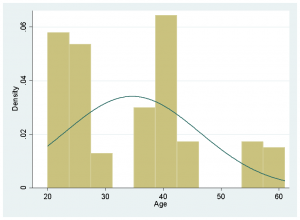
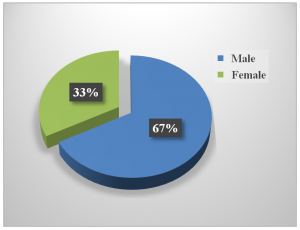
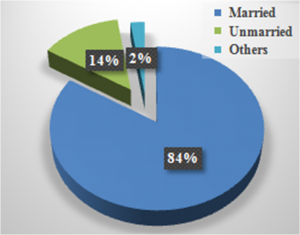
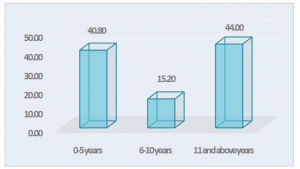
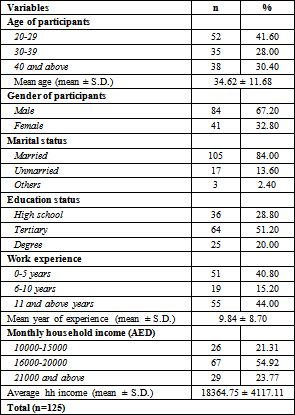
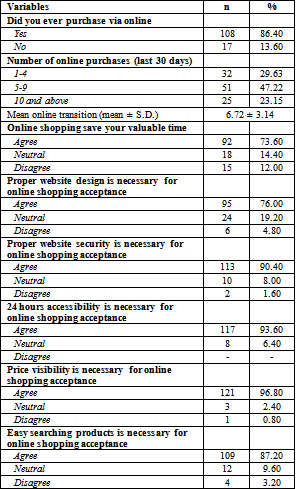

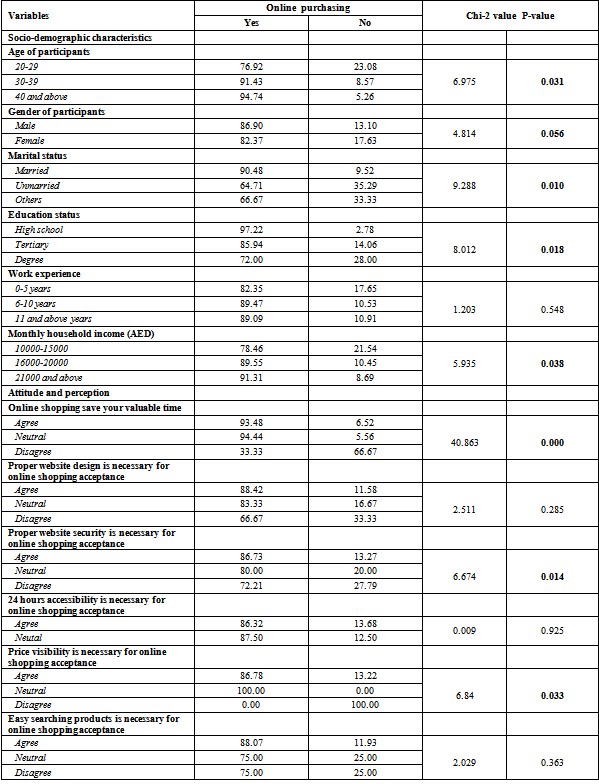
6. Conclusion and Recommendations
These study findings were similar to the recent online consumer behavior study conducted by 15. One significant conclusion of this study is that gender significantly correlates with consumer behavior in online shopping and online purchasing intentions. Married consumers are more likely to make online purchases when compared to unmarried consumers. However, the study concluded that possible reason for this is that married consumers typically must buy more products for their family members than unmarried consumers 15. There is also a significant association between household income and acceptance of online shopping. The respondents’ attitudes toward e-commerce, measured by a positive response to some of its benefits, including saving valuable time, website security, and price visibility proved to be important factors associated with the acceptance of e-commerce or online shopping in the UAE.
This study was based on a cross-sectional study design with the small sample size of 125 respondents. Therefore, further research on consumer behavior about e-commerce and the acceptance of online shopping using a much larger sample size should be conducted in the UAE. The small sample size used in this study is likely to be not accurately representative of the UAE population. This study, however, can help policy-makers make more effective decisions involving e-commerce.
References
Adebiaye, Richmond, (2017). Investigating IT Effectiveness: Perspectives Relative to Cultural Differentiation Between IT Users and Service Providers; American Journal of Networks and Communications (AJNC), Science Publishing Group, 2017; Volume 6, Issue 3, June 2017, Pages: 54-61.
Adebiaye, Richmond, (2017). Interpreting User’s perceptions of Mobile Security Methods and Their Effectiveness; International Journal of Engineering and Advanced Technology (IJEAT). Volume 6, Issue 4 (April 2017) PP: 01-18.
Adebiaye, Richmond, Boumedyen Shannaq, (2017). Schemes for Distributed Computing Environment Based on Cloud Computing Technology for Ministry of Regional Municipalities and Water Resources (MRMWR); International Journal of Engineering Inventions (IJEI). Volume6, Issue 1 (Jan2017) PP: 01-06.
Adebiaye, Richmond, Boumedyen Shannaq, Abdallah Bawain, (2017). Strategic Information Systems Cutting-Edge Change Management For Ministry of Regional Municipalities and Water Resources (MRMWR), Sultanate of Oman; International Journal of Scientific & Engineering Research (IJSER), Volume 8 Issue 3, March 2017: (pp01-09).
Adebiaye, Richmond, Boumedyen Shannaq, (2017) A Security Analysis To Be Technology Architecture For Ministry of Regional Municipalities and Water Resources (MRMWR); International Journal of Research in Social Sciences (IJRSS). Volume 6, Issue 1(Jan 2017) PP:01-06.
Adebiaye, Richmond, Haroun Alryalat, Khalid Ammar, (2016) Interpreting Causes of Attrition in an Information Technology (I.T.) Undergraduate Degree Program within a Gulf State Regional University: International Journals of Multidisciplinary Research Academy (IJMRA)) Vol. 6 Issue 11, October 2016 publication.
Adebiaye, Richmond, Haroun Alryalat, Theo Owusu, (2016) Perspectives for Cyber-Deterrence: A Quantitative Analysis of Cyber Threats and Attacks on Consumers: International Journal Of Innovative Research in Science, Engineering and Technology (IJIRSET) Vol. 5 Issue 7, August 2016. PP 01-18.
Adebiaye, R. S., & Conner, C., (2015). “Chiropractor Practice Management: Justifications for Business Degree Program in Chiropractic Curriculum”. International Journal of Advanced Scientific Research & Development (IJASRD), 02 (03/I), pp.01-15.
Adebiaye, R. S., & Conner, C., (2015). “Chiropractor Practice Management: Justifications for Business Degree Program in Chiropractic Curriculum”. International Journal of Advanced Scientific Research & Development (IJASRD), 02 (03/I), pp.01-15.
Jain, D., Goswami, S., Bhutani.S., (2014). “Consumer behavior towards online shopping.”An Empirical Study from Delhi. 16(9): 65-72.
Janacek, R., Muchhala, M., (2004). “The method of transferring data from a sender to a recipient during which a unique account for the recipient is automatically created if the account does not previously exist.” Google Patent.
Jarvenpaa, S.L., P.A. Todd, (1997). “Consumer Reactions to Electronic Shopping on the World Wide Web,” Journal of Electronic Commerce, Vol. 1, No. 2: 59-88.
Kimani, S., (2016). University of Nairobi school of computing and informatics: a time-series forecasting approach to prediction of the refugee population in Kenya.
Kuester, Sabine., (2012). MKT 301: Strategic marketing and marketing in specific industry contexts. The University of Mannheim.
Salehi, M., (2011). “Consumer buying behavior towards online shopping stores in Malaysia.”International Journal of Academic Research in Accounting, Finance and Management Sciences, 1(2): 10.
Vel. P. & Rodrigues, J., (2013). “Online purchase of luxury products in the U.A.E.” International Journal of Social, Human Science, and Engineering, 7(7): 506-11.









